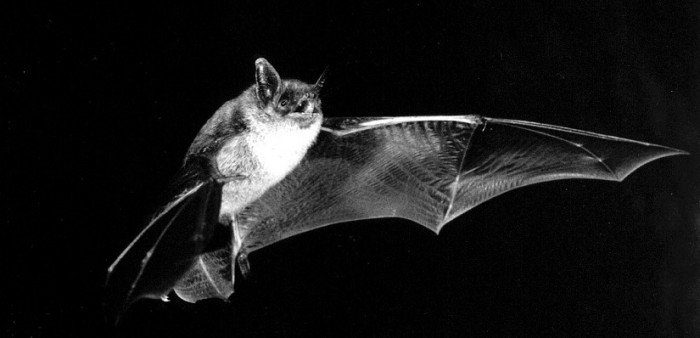Today’s post comes from Natural Heritage Education Supervisor Alistair MacKenzie and Bat Stewardship Technician Heather Sanders.
Did you know Pinery Provincial Park has been a bat research hot spot for more than four decades? We’ve collaborated with research groups at York University, Western University and the University of Waterloo.
Much of what we know about Ontario bats — including their migration, diet, and behaviour — is all thanks to work done at Pinery.
The Friends of Pinery Park, with a grant from the Species at Risk Stewardship Fund (SARSF), is supporting a project focusing on the endangered Little Brown Myotis.

We’re aiming to improve our knowledge of bat biology and behaviour, as well as bettering our understanding of how White Nose Syndrome is affecting bat populations at Pinery.
Our work consists of two major components: research and education.
Research
Over the last few years, we have built and erected nearly 40 four-chambered and rocket-box-style bat boxes throughout the park.
With the assistance of a team of bat researchers at the University of Waterloo (led by Dr. Hugh Broders), we capture, tag, and release bats back into the park with PIT (passive integrated transponder) tags. These tags can be identified by readers installed on our bat boxes.

This lets us track individual bat movement through the park in order to better understand factors involved in roost selection and bat colony movement.
In 2018, we received funding to acquire and install the first three PIT tag readers!
To further augment bat habitat in the park, we have also constructed and erected a large communal “bat condo.”
This design was successfully tested in Wisconsin and is capable of housing up to 3,000 Little Brown Myotis bats. Our condo opened for winged tenants in October of 2018, and can be found near Pinery’s Outdoor Theatre.

Furthermore, we have placed several bat recorders in the park to record the high-pitched echolocation calls that bats use to supplement their vision at night. These recordings are being analyzed to identify species, and enable us to monitor changes in bat populations in the park
Education

As part of this project, we have designed numerous new bat resources, including information cards, postcards, posters, and bat box plans.
These are available for guests, free of charge at the Visitor Centre.
Additionally, naturalists and researchers lead several different bat education programs and talks throughout the summer and at special events in the park and the surrounding community.
Want to help our project?
Donate
Important research and stewardship work like this project cannot succeed without the necessary funding required to hire field staff, purchase equipment and supplies, and produce reports and educational content.

The sophisticated acoustic and PIT reader technology is expensive and requires elaborate solar-charging equipment to provide power in the remote areas of the park.
Support the Friends of Pinery Park’s bat stewardship project by making a charitable donation through Canada Helps, writing a cheque, or taking part in one of our annual fundraising events, such as the annual raffle or the Pinery Fall Classic.
Participate in our Citizen Science Project
We need your help!
Bat detectors pick up the high frequency sounds that bats use to “see” at night and make them audible to the human ear.

Come to the Visitor Centre to sign out a bat detector for up to two nights! Explore the park, listening for bats and recording what you find.
When you return your detector to the Visitor Centre, mark your findings on our map or submit your sightings on your mobile phone through the Explore Pinery app, available for free from the App Store or Play Store!
Note: borrowing a bat detector requires a refundable hold on your credit card for the value of the equipment.
Build bat boxes
Historically, Little Brown Myotis Bats roost in hollow trees during the summer months. Unfortunately, most are cut down by people that think they’re dangerous or ugly.
Give bats a place to stay during the day and to raise their young during the summer months by building or buying a bat box. Providing these boxes encourages bats to use them rather than moving into your own home.
Download plans for a bat house from Bat Conservation International.
Plant native species
Bats eat flying insects, and many only live on native tree and shrub species. The more native species there are in your area, the more bats, birds, and other wildlife you’ll see!

Buttonbush (Cephalanthus occidentalis), Evening Primrose (Oenothera biennis), and New England Aster (Symphyotrichum novae-angliae) all help provide food for bats.
Learn about bats
These fascinating animals are very unique. They deserve our appreciation and respect.
Learn by:
- coming to one of Pinery’s bat programs or night hikes
- borrowing a bat detector to look for bats yourself
- picking up bat informational materials at the Visitor Centre
- booking a class trip to the Pinery Provincial Park
- reading our bat creature feature post
For more information, check out:
Assistance for this project was provided by the Government of Ontario.
Additional funding was provided by the Toronto Dominion Friends of the Environment Foundation (TDFEF).

